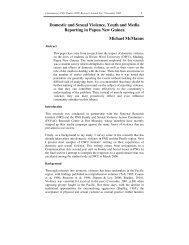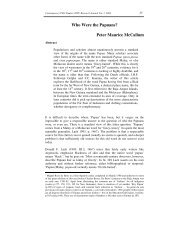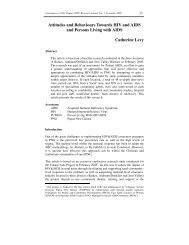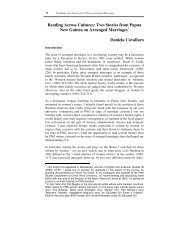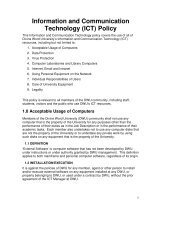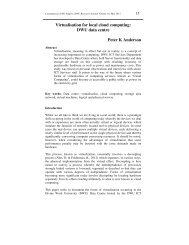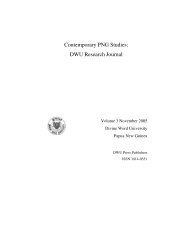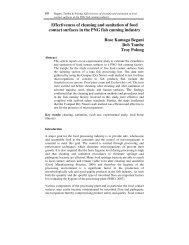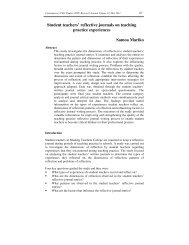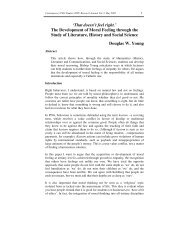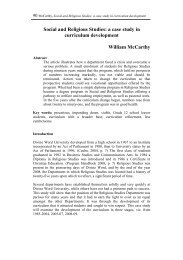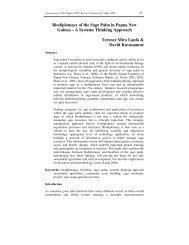A short study of Melpa rehistory - Divine Word University
A short study of Melpa rehistory - Divine Word University
A short study of Melpa rehistory - Divine Word University
- No tags were found...
You also want an ePaper? Increase the reach of your titles
YUMPU automatically turns print PDFs into web optimized ePapers that Google loves.
12Howley, A Short Study <strong>of</strong> <strong>Melpa</strong> P<strong>rehistory</strong>female opposition. Even among the <strong>Melpa</strong> there was the awareness that loyaltyto the clan was a matter <strong>of</strong> survival. Loyalty to the clan was a matter <strong>of</strong> survivaldue to the principle <strong>of</strong> collective responsibility that marked all extended familymembers as possible victims <strong>of</strong> payback or compensation. War required astrong united force which was developed by training and practice. In the finalconfrontation with an enemy it was numbers and unity that counted. Thisfeature <strong>of</strong> highland society differs noticeably from the tribes in the lowlandsand coastal regions where fertility cults are the norm and manhood isemphasised.In the place <strong>of</strong> initiation, children learned the values, customs and rituals <strong>of</strong> theclan. This learning generally took place at puberty and included matters <strong>of</strong>male growth, sexuality, sexual attributes, the dangers <strong>of</strong> pollution, the symboliclinks between land and the food grown on it, and the symbolic connectionsbetween blood, food, meat, semen, flutes and yams. They had also to learnabout the wider world, the rules <strong>of</strong> mutual reciprocity, brother-sister relations,marriage links/relations and the legitimacy <strong>of</strong> <strong>of</strong>fspring (Strathern, 1984, p.51)Tribal fightingMaking war has been said to be ‘the most universal and probably the oldest <strong>of</strong>the tribe's functions’. No central authority is needed for this purpose as is thecase with making and keeping peace. War has been claimed to be universal andpresent in all parts <strong>of</strong> the world wherever there have been men (Davitt, 1968,p.44).Fighting within one’s own tribe and clan was forbidden by the social contractbut killing <strong>of</strong> enemies was an honourable activity. Normal causes <strong>of</strong> warfare inthe highlands were blood-revenge, women, pigs, insults, sorcery accusations,and disputes about ownership <strong>of</strong> land or food resources. Much <strong>of</strong> the fightingwas <strong>of</strong> a ritual nature to maintain the boundaries, to gain prestige and gain areputation. Some did it for recreation and an opportunity to boast before theircommunity friends. Warfare was also a counter in politics where men withpolitical ambitions or other motivations used the fight to strengthen their ownpositions in the moka or the female cult.Usually the fighting men arrived for the fight decorated with paint and feathersas though for a celebration. In any tribal fight there would be a good turn outfor young men who wanted plenty <strong>of</strong> excitement and little real danger (Berndt,1964, p.184). The enemy were accepted as opponents in a very dangerousathletic game. However if the enemy faltered, they paid for it with physicalhurt and emotional humiliation and also with destruction, loss <strong>of</strong> movableproperty, and even loss <strong>of</strong> land, with all that this entailed.Warfare in traditional highlands societies has been regarded as chronic,incessant, or endemic, and is said to have been accepted as a part <strong>of</strong> socialliving in most areas. When Chinnery visited Hagen in 1933, he remarked that‘intertribal fighting constantly takes place, the weapons being the spear,



